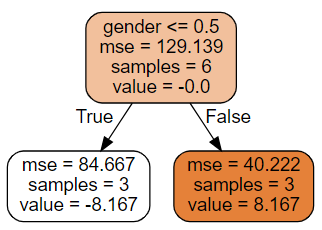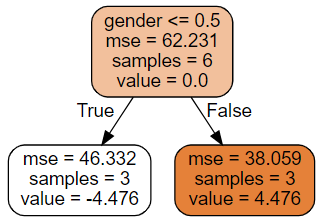Gradient Boosting (GB) algorithm trains a series of weak learners and each focuses on the errors the previous learners have made and tries to improve it. Together, they make a better prediction.
According to Wikipedia, Gradient boosting is a machine learning technique for regression and classification problems, which produces a prediction model in the form of an ensemble of weak prediction models, typically decision trees. It builds the model in a stage-wise fashion as other boosting methods do, and it generalizes them by allowing optimization of an arbitrary differentiable loss function.
Prerequisite
1. Linear regression and gradient descent
2. Decision Tree
After studying this post, you will be able to:
1. Explain gradient boosting algorithm.
2. Explain gradient boosting regression algorithm.
3. Write a gradient boosting regressor from scratch
The algorithm
The following plot illustrates the algorithm.

(Picture taken from Youtuber StatQuest with Josh Starmer)
From the plot above, the first part is a stump, which is the average of y. We then add several trees to it. In the following trees, the target is not y. Instead, the target is the residual or the true value subtract previous prediction.
That is why we say in Gradient Boosting trains a series of weak learners, each focuses on the errors of the previous one. The residual predictions are multiplied by the learning rate (0.1 here) before added to the average.
The Steps
Step 1: Calculate the average of y. The average is also the first estimation of y:
Step 2 for m in 1 to M:
Step 2.1: Compute so-call pseudo-residuals:
Step 2.2: Fit a regression tree to pseudo-residuals and create terminal regions (leafs) for
Step 2.3: For each leaf of the tree, there are $p_j$ elements, compute $\gamma$ as the following equation.
(In practice, the regression tree will do this for us.)
Step 2.4: Update the model with learning rate $\alpha$:
Step 3. Output
In practise the regression tree will average the leaf for us. Thus, Step 2.2 and 2.3 can be combined into one step. And the steps can be simplified:
New The Steps
Step 1: Calculate the average of y. The average is also the first estimation of y:
Step 2 for m in 1 to M:
- Step 2.1: Compute so-call pseudo-residuals:
Step 2.2: Fit a regression tree $t_m(x)$ to pseudo-residuals
Step 2.3: Update the model with learning rate $\alpha$:
Step 3. Output
(Optional) From Gradient Boosting to Gradient Boosting Regression
The above knowledge is enough for writing BGR code from scratch. But I want to explain more about gradient boosting. GB is a meta-algorithm that can be applied to both regression and classification. The above one is only a specific form for regression. In the following, I will introduce the general gradient boosting algorithm and deduce GBR from GB.
Let’s first look at the GB steps
The Steps
Input: training set , a differentiable loss function , number of iterations M
Algorithm:
Step 1: Initialize model with a constant value:
Step 2 for m in 1 to M:
- Step 2.1: Compute so-call pseudo-residuals:
Step 2.2: Fit a weak learner to pseudo-residuals. and create terminal regions , for
Step 2.3: For each leaf of the tree, compute $\gamma$ as following equation.
- Step 2.4: Update the model with learning rate $\alpha$:
Step 3. Output
To deduce the GB to GBR, I simply define a loss function and solve the loss function in step 1, 2.1 and 2.3. We use sum of squared errror(SSE) as the loss function:
For step 1:
Because SSE is a convex and at the lowest point where the derivative is zero, we have the following:
Thus, we have:
For step 2.1:
(The chain rule)
For step 2.3:
Similarly, the result is:
Code
Let’s first import the modules.
1 | import pandas as pd |
And load data.
1 | df=pd.DataFrame() |
The data is display as:
| name | height | gender | weight |
|---|---|---|---|
| Alex | 1.6 | male | 88 |
| Brunei | 1.6 | female | 76 |
| Candy | 1.5 | female | 56 |
| David | 1.8 | male | 73 |
| Eric | 1.5 | male | 77 |
| Felicity | 1.4 | female | 57 |
And X is:
| height | gender |
|---|---|
| 1.6 | 1 |
| 1.6 | 0 |
| 1.5 | 0 |
| 1.8 | 1 |
| 1.5 | 1 |
| 1.4 | 0 |
Step 1 Average
1 | #now let's get started |
The average and residuals are as following:
| name | height | gender | weight | 𝑓0 | 𝑟0 | |
|---|---|---|---|---|---|---|
| 0 | Alex | 1.6 | male | 88 | 71.166667 | 16.833333 |
| 1 | Brunei | 1.6 | female | 76 | 71.166667 | 4.833333 |
| 2 | Candy | 1.5 | female | 56 | 71.166667 | -15.166667 |
| 3 | David | 1.8 | male | 73 | 71.166667 | 1.833333 |
| 4 | Eric | 1.5 | male | 77 | 71.166667 | 5.833333 |
| 5 | Felicity | 1.4 | female | 57 | 71.166667 | -14.166667 |
In the first step, we calculate the average 71.2 as the initial prediction. The pseudo residuals are 16.8, 4.8, etc.
Step 2 For Loop
We define each iteration as following and we will call it from i=0 to 5.
1 | def iterate(i): |
Iteration 0

| name | height | gender | weight | 𝑓0 | 𝑟0 | 𝛾1 | 𝑓1 | 𝑟1 | |
|---|---|---|---|---|---|---|---|---|---|
| 0 | Alex | 1.6 | male | 88 | 71.166667 | 16.833333 | 8.166667 | 72.800000 | 15.200000 |
| 1 | Brunei | 1.6 | female | 76 | 71.166667 | 4.833333 | -8.166667 | 69.533333 | 6.466667 |
| 2 | Candy | 1.5 | female | 56 | 71.166667 | -15.166667 | -8.166667 | 69.533333 | -13.533333 |
| 3 | David | 1.8 | male | 73 | 71.166667 | 1.833333 | 8.166667 | 72.800000 | 0.200000 |
| 4 | Eric | 1.5 | male | 77 | 71.166667 | 5.833333 | 8.166667 | 72.800000 | 4.200000 |
| 5 | Felicity | 1.4 | female | 57 | 71.166667 | -14.166667 | -8.166667 | 69.533333 | -12.533333 |
In Iteration 0, we first train a tree using residuals_0. This tree tells us that males are higher than females, each male should add 8.167 kg, each female subtracts -8.167 kg. The result of the tree is here. But, we want to take just a small step a time, so we multiply the learning rate . Thus, the new prediction is . That is to say, for each male, he will add kg. For each female, she will lose kg. Finally, the males are predicted 72.8 kg and females 69.5.
Iteration 1

| name | height | gender | weight | 𝑓1 | 𝑟1 | 𝛾2 | 𝑓2 | 𝑟2 | |
|---|---|---|---|---|---|---|---|---|---|
| 0 | Alex | 1.6 | male | 88 | 72.800000 | 15.200000 | 7.288889 | 74.257778 | 13.742222 |
| 1 | Brunei | 1.6 | female | 76 | 69.533333 | 6.466667 | 7.288889 | 70.991111 | 5.008889 |
| 2 | Candy | 1.5 | female | 56 | 69.533333 | -13.533333 | -7.288889 | 68.075556 | -12.075556 |
| 3 | David | 1.8 | male | 73 | 72.800000 | 0.200000 | 7.288889 | 74.257778 | -1.257778 |
| 4 | Eric | 1.5 | male | 77 | 72.800000 | 4.200000 | -7.288889 | 71.342222 | 5.657778 |
| 5 | Felicity | 1.4 | female | 57 | 69.533333 | -12.533333 | -7.288889 | 68.075556 | -11.075556 |
In iteration 1, we firstly train a tree using residuals_1. This tree tells us height is also important in determining weight. Whose who are less than 1.55 meters are supported to lose -7.289 and the other to gain 7.289. Again, we want to shrink this to 20%, which is -1.4578 and 1.4578. We then make prediction_2 based on prediction_1 and . We see Alex gains 1.4578 kg because he is 1.6. Other also gain or lose weight because of the new rule.
Iteration 2

| name | height | gender | weight | 𝑓2 | 𝑟2 | 𝛾3 | 𝑓3 | 𝑟3 | |
|---|---|---|---|---|---|---|---|---|---|
| 0 | Alex | 1.6 | male | 88 | 74.257778 | 13.742222 | 6.047407 | 75.467259 | 12.532741 |
| 1 | Brunei | 1.6 | female | 76 | 70.991111 | 5.008889 | -6.047407 | 69.781630 | 6.218370 |
| 2 | Candy | 1.5 | female | 56 | 68.075556 | -12.075556 | -6.047407 | 66.866074 | -10.866074 |
| 3 | David | 1.8 | male | 73 | 74.257778 | -1.257778 | 6.047407 | 75.467259 | -2.467259 |
| 4 | Eric | 1.5 | male | 77 | 71.342222 | 5.657778 | 6.047407 | 72.551704 | 4.448296 |
| 5 | Felicity | 1.4 | female | 57 | 68.075556 | -11.075556 | -6.047407 | 66.866074 | -9.866074 |
Iteration 2 again tells us that gender matters.
Iteration 3

| name | height | gender | weight | 𝑓3 | 𝑟3 | 𝛾4 | 𝑓4 | 𝑟4 | |
|---|---|---|---|---|---|---|---|---|---|
| 0 | Alex | 1.6 | male | 88 | 75.467259 | 12.532741 | 5.427951 | 76.552849 | 11.447151 |
| 1 | Brunei | 1.6 | female | 76 | 69.781630 | 6.218370 | 5.427951 | 70.867220 | 5.132780 |
| 2 | Candy | 1.5 | female | 56 | 66.866074 | -10.866074 | -5.427951 | 65.780484 | -9.780484 |
| 3 | David | 1.8 | male | 73 | 75.467259 | -2.467259 | 5.427951 | 76.552849 | -3.552849 |
| 4 | Eric | 1.5 | male | 77 | 72.551704 | 4.448296 | -5.427951 | 71.466114 | 5.533886 |
| 5 | Felicity | 1.4 | female | 57 | 66.866074 | -9.866074 | -5.427951 | 65.780484 | -8.780484 |
Iteration 3 argues that height is important, too.
Iteration 4

| name | height | gender | weight | 𝑓4 | 𝑟4 | 𝛾5 | 𝑓5 | 𝑟5 | |
|---|---|---|---|---|---|---|---|---|---|
| 0 | Alex | 1.6 | male | 88 | 76.552849 | 11.447151 | 4.476063 | 77.448062 | 10.551938 |
| 1 | Brunei | 1.6 | female | 76 | 70.867220 | 5.132780 | -4.476063 | 69.972007 | 6.027993 |
| 2 | Candy | 1.5 | female | 56 | 65.780484 | -9.780484 | -4.476063 | 64.885271 | -8.885271 |
| 3 | David | 1.8 | male | 73 | 76.552849 | -3.552849 | 4.476063 | 77.448062 | -4.448062 |
| 4 | Eric | 1.5 | male | 77 | 71.466114 | 5.533886 | 4.476063 | 72.361326 | 4.638674 |
| 5 | Felicity | 1.4 | female | 57 | 65.780484 | -8.780484 | -4.476063 | 64.885271 | -7.885271 |
Let’s stop at Iteration 4. And take a look at the loss.

Hope you get the idea.
The code is hosted at my github repo:
Reference:
https://en.wikipedia.org/wiki/Gradient_boosting
https://www.youtube.com/watch?v=3CC4N4z3GJc&list=PLblh5JKOoLUICTaGLRoHQDuF_7q2GfuJF&index=44
https://www.youtube.com/watch?v=2xudPOBz-vs&list=PLblh5JKOoLUICTaGLRoHQDuF_7q2GfuJF&index=45
This article is based on a video from StatQuest, I strongly recommend this Youtube channel.